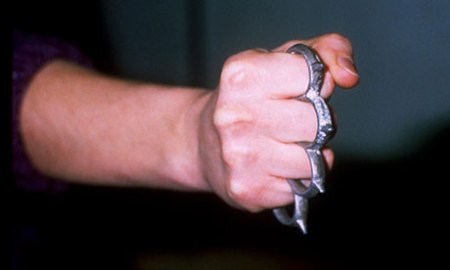Back in 2008, when Lady Gaga mania began, it often felt like you couldn’t avoid her. There were the hit records, of course – Poker Face, Telephone and Bad Romance to name just three. But in the space of a few years there were also the meat dresses, the Grammy performances in giant eggs and an almost regular stream of controversy. You’d be forgiven for thinking that the popstar, born Stefani Germanotta, was constantly thrusting herself into the public eye – but the reality, she says, was quite different.
“I hid in my house,” she explains matter-of-factly when I meet her before the opening night of the iTunes festival at the Roundhouse in north London. “I hid a lot … to preserve my image as a superstar to my fans. I don’t mean I am a superstar, I mean that they only ever see me at my best. And it really drove me crazy. So I’ve really had to make more of an effort to go out more. I mean, can you imagine what it’s like not to feel real wind? Honestly, I hadn’t felt real wind for years!”
Gaga prides herself on putting her fans first, and in this instance it seems she didn’t want her fans to ever see her as a normal human being. “I would be indoors all day and then I’d get in a car in a garage and then drive to another garage and get out and rehearse and then do it again, from country to country, and never walk outside. I remember some of the longest walks I had were from the car to the aeroplane on the tarmac.”
During this performance Gaga will perform the title track from her forthcoming album ARTPOP and utter a line that sums up everything her fans love about her and her critics detest: “My art-pop could mean anything,” she coos over a lilting electronic throb. To her detractors – of which there seem to be a growing number – she’s the perfect example of the dichotomy of the globe-straddling megastar spouting empty signifiers with the meaning crowbarred in afterwards. To her hardcore fans (or “Little Monsters”), she’s not only the greatest pop star on the planet, but a sort of cult leader whose mantra of self-love, implemented on her last album Born This Way, acts as their Bible.
Perhaps aware of her Marmite appeal, today Gaga is immediately on the charm offensive, giving me a kiss on arrival and complementing me on my shoes (at one point she bends down to stroke the material). Her PR and manager, both lurking near the door, are instructed to sit down and “stay quiet”. Shuffled back on an armchair so that her giant heels swing off the ground, she has the mannerisms of a well-behaved toddler. But there’s also an ever-present strain of determination that underlines everything she says. You sense she’s aware that while 2011’s Born This Way album sold 6m copies worldwide, many saw it as a the end of her imperial phase, with the album’s last single Marry the Night becoming her first to miss the US top 10. With only one single released so far – the 80s electropop of Applause – there’s a palpable feeling that the ARTPOP campaign is already stalling, with the single yet to reach the top three in either America or the UK.
A few weeks ago, Gaga tweeted a Michael Jackson quote that read: “The bigger the star, the bigger the target”. Does she feel persecuted? “Yeah, for sure I do,” she replies without hesitation, her skintight jumpsuit parping with her every movement. “Yes! I certainly feel that at this time it’s almost as if people are surprised they haven’t already destroyed me.”
She puts a straw to her mouth and takes a dramatic slurp. “It gives them a sense of pleasure when they believe that they’ve destroyed me or taken me down. It’s almost entertainment for people to poke fun at Lady Gaga, but at the very same time they have no idea the album I’ve made. They have no idea what I put into this, they have no idea the work that I’ve put behind my performances and what I do. In fact, people have no idea what it really took for me to get here. So it doesn’t bother me, it’s just an interesting observation of where we are as a society.”
Before being asked about it, she brings up the success or otherwise of Applause: “It’s literally not even been two weeks since my first single came out and it’s all, ‘She’s over’, or because I’m not No 1 yet, ‘She’s finished’. People focus less on the music and focus more on how the music’s doing; how it’s faring from a numbers perspective, from a financial perspective. If you think I give a damn about money then you don’t know me as an artist at all.” She adds: “I think that once you’ve had a few No 1s in your career that you’ve kind of proven yourself and I don’t feel the need to prove anything anymore.”
For some, Applause’s failure to connect in the way her previous singles have done is down to the fact that it appears to be solely about Gaga and for Gaga. Written after she had to cancel her Born This Way Ball Tour at the beginning of the year, the result of a severe hip injury that required an operation and left her in a wheelchair, the song is about the need she has as a pop star to experience adulation from a crowd.
Gaga says she would have tried to keep the hip operation a secret – to shield her fans once more – if she had managed to make it to the end of her tour, but it wasn’t possible. “I was wheelchair-bound two weeks before that even happened,” she says. “That I did hide from them because I didn’t want to stop the show. I know everyone was thinking I was trying to be a bit silly with my gold wheelchair but I was really trying to keep a bit of strength for my fans because it really upset them and scared them.”
Gaga disputes the idea that Applause is a song for herself. Rather, she says, it is as universal as any love song. “It’s so interesting for people to say that the lyrics are all about me the performer,” she says, somewhat disingenuously. “I want you to feel that way about yourself, that’s why I wrote the song. I want you to wake up in the morning and say: ‘I live for your applause, look at me today, I’m having a great day, I’m going to work and I’m going to have a fantastic lunch with my friends.’ But it’s not to be taken quite as seriously and as literally as people make it to be, which is why in the verses I’m sort of making fun of what people think about fame.”
It is this sense of humour that Gaga’s critics tend to forget, or have been more likely to forget since Born This Way’s heavy-handed “we are all equal” didacticism. Like Michael Jackson before her, it often felt like the Biggest Pop Star on Earth was creating music not for the everyday pop fan who might buy an album, but for the first 20 rows of dressed up, banner-waving, camped-out-since-4am apostles. When you talk about your fans, who do you mean? “I mean everybody. I mean anyone that’s watching.”
Gaga concedes that it can be “uncomfortable” to fall in love with a pop star that has more to her under the surface than was bargained for. “Suddenly the pop star takes off her sheep’s clothing and you see the kind of dingy, underground, metal-loving girl from New York who wants to talk about equal rights and go on and on and on about loving yourself. I made a choice to show people that,” she says. “I made a choice to do that because I wanted them to know that for the rest of my career, underneath every outfit that I have on, that girl is always underneath. With ARTPOP I’m veering in a new direction in terms of my messaging, but Born This Way was all about that particular message.”
Did you anticipate that this would lose you fans? “I was comfortable with just speaking to the ones that really needed to hear the message and confident that I had enough great songs on the album that the general public would latch on to,” she says. “People can say whatever they want about whether or not I enforced change [in her fans’ lives] or if it’s all fake, but the truth of it is I travelled the entire length of the world with the tour.”
At this point she rattles off audience attendance figures at various venues, checking facts with her manager, before, seemingly apropos of nothing, adding: “I know people said I wasn’t selling out in America but that was entirely untrue, we sold out all over the world and every night I looked out into the fans and those front rows that you’re talking about, the tears, the honesty, the inability to not be completely overjoyed because they felt accepted. That’s sometimes more powerful than making a pop song and it just was at that time.”
We talk briefly about the recent MTV VMA awards, which she opened with a dazzling, Botticelli-influenced performance of Applause. Even that, however, was overshadowed by Miley Cyrus and her semi-naked grinding of Robin Thicke’s groin area. “For me, my performance was not about taking clothes off, if that makes sense. I wanted it to be strong and beautiful and powerful and full of confidence. It doesn’t bother me, though, that there was a lot of attention paid to any other performances, it’s not a competition. I do what I do and they do what they do. Isn’t it nice that it all happened and that it’s all been recorded and we can watch it all – it’s not like the good things stay and everything else gets erased.”
It’s rare for a pop star of Lady Gaga’s stature to acknowledge failure and she seems, on the surface at least, happy to concede that some of the novelty of what she does has worn off slightly. In fact, she is open about the fact that things needed to change following Born This Way.
“I had really tried to hide a lot of my pain from my past in the last few years,” she says towards the end of the interview, whereas at the Roundhouse a new song, Swine, is introduced with, “My heart, my skin and my pussy felt like trash.” It seems to hint at domestic abuse. Does this hint at Gaga’s future direction? That she’s ready to come out of hiding, to reveal herself?
“For ARTPOP, I, in the most metaphorical explanation, stood in front of a mirror and I took off the wig and I took off the makeup and I unzipped the outfit and I put a black cap on my head and I covered my body in a black catsuit and I looked in the mirror and I said: ‘OK, now you need to show them you can be brilliant without that.’ And that’s what ARTPOP is all about. Because I knew that if I wanted to grow, if I really wanted to innovate from the inside, I had to do something that was almost impossible for me.”
The Guardian, http://www.theguardian.com/music/2013/sep/03/lady-gaga-people-think-im-finished










